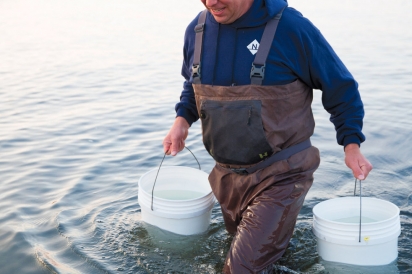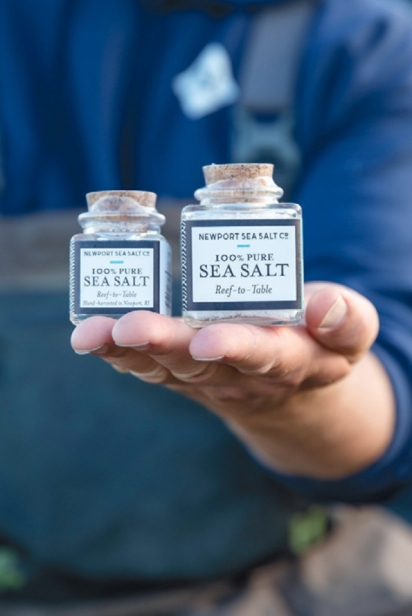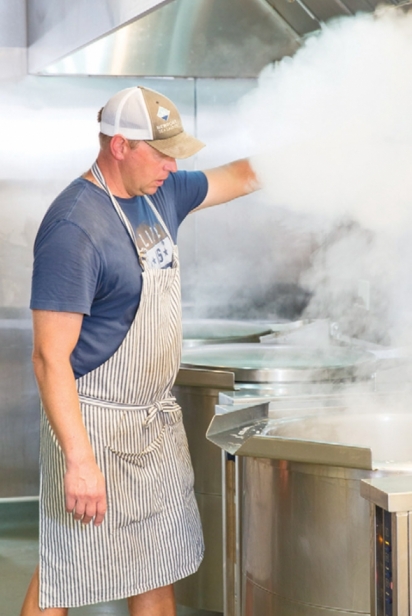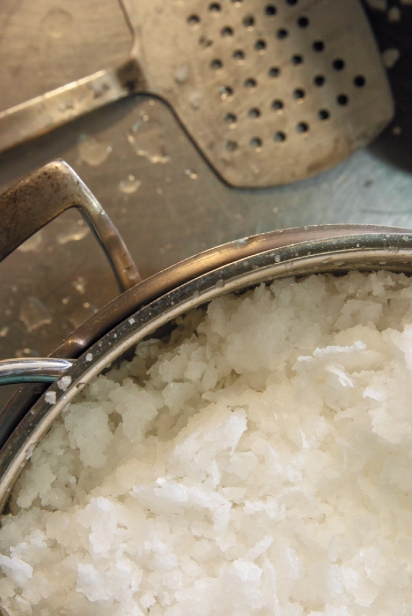Going Reef to Table with Newport Sea Salt
Bringing More Flavor to Rhode Island, One Bucket of Saltwater at a Time
It’s 5 am and Matt Mullins wades into the dark water near Brenton Point State Park in Newport. High tide billows at his waist as he hauls two (five-gallon) buckets of saltwater to shore. He is alone, except for hungry cormorants and seagulls. The warming sunrise begins to paint the sky in shades of dusty rose and lavender. Mullins, a retired Naval officer, is in his element.
The buckets land on the rocks with a sloshy thud. He pours the water through a mesh filter so fine it can catch a grain of sand, followed by an even finer mesh to filter out any trace impurities. His license plate reads “CSalt” as he heaves the hefty buckets up the rocks and into the truck’s bed. Back and forth, 28 buckets’ worth, until it’s filled to the brim. That’s 140 gallons of prime Atlantic Ocean saltwater.
Checking the weather and timing for the highest tides begins each harvest for Mullins, co-owner and chief producer of Newport Sea Salt. The company that he founded with his wife, Tami, at their kitchen table in 2016 now dispatches him across the state—harvesting in Newport, boiling and packaging at Hope & Main in Warren, delivering bulk orders to Providence and selling directly to Aquidneck Growers Market customers.
“Even before we thought of a business, it started as an experiment with our kids,” he says humbly. “It felt like a crazy idea. I mean, what house, hotel and restaurant doesn’t already have salt? But I started looking in Rhode Island and couldn’t find a local sea salt company. We’re the Ocean State; why wasn’t there a sea salt company?”
Hoping to mimic the authentic flavors the family came to treasure during a three-year U.S. Navy duty station tour in Italy, Mullins and his two sons collected a half-gallon of seawater on a whim. (Mullins chose the fast-moving waters off Brenton Point then and now because it is monitored by the state for shellfishing.) They boiled it down on the stove and sprinkled the few ounces of salt on Tami’s chocolate chip cookies. Friends and neighbors soon requested their own supply.
Now, three years later, 140 gallons at a clip isn’t enough to meet demand.
GRAIN OF SALT
It turns out producing sea salt is much more than watching water boil. Though it only takes Mullins about an hour to collect and filter the water, the bewitching boiling process to extract the salt can take more than nine hours at Hope & Main, where Mullins rents commercial kitchen space several days a month. He always has more than one batch boiling at a time, and he hustles from kettle to packaging table juggling the different phases of production.
“You can’t force the salt to hurry up,” he says. “I can turn the heat up from 212°F, but it won’t make a difference. It’s a natural process, so I just have to let the crystals grow.”
He didn’t know that when he first started. “My first batch at Hope & Main didn’t go well. All I had used until then was my kitchen, so I had no idea how to best use the large equipment,” he admits. “I overboiled it and it turned to powdery mush.”
Now this master multi-tasker stews seawater in stages: fast and furious, then low and slow. Allowing 140 gallons of seawater to boil rapidly [for a few hours] in 40-gallon batches encourages as much evaporation as possible from the steam jacketed kettle. “The sequence of salt precipitation varies, so I look for 88–98% evaporation rate,” Mullins says.
He transfers it to a smaller round kettle one bowl at a time for another round of deep boiling, then to a tilt skillet to simmer. This rectangular tilt skillet is only a foot deep and a few feet wide, allowing even heat distribution across the surface.
The salt crystals form a solid crust within a few hours. Resembling an iceberg, with peaks and valleys of texture, they tumble to the bottom when they reach maximum density. “It has a thick layer of salt on top, and it’s boiling underneath, with crystals hardened on the side, like ice on a windshield,” says Mullins, tapping the toughened mass with his spoon. “Different temperatures create different crystal sizes, which I like. You’ll never see homogenous shapes and sizes with our salt.”
The biggest difference is visual, at first. “When you open up a bottle of our salt, you see all different shapes and sizes of crystals,” says Mullins. “That’s the difference with sea salt and table salt. Ours is a little bit different, more handcrafted and imperfect—and it has natural trace minerals like potassium and magnesium. We never use anti-caking agents, bleaching or additives.”
With a slotted spoon, Mullins scoops out mounds of coarse sea salt, placing it into a colander to drain excess liquid. As he keeps scooping, a mountain of precious white arises from the steam. “It’s amazing how salt is naturally this white,” he marvels.
As more and more salt forms and falls in the tilt skillet, Mullins’s colander steadily fills, and at the end of his shift, three large Tupperware containers of salt await packaging. After processing 140 gallons of water, he generates roughly 27 to 31 pounds of salt, just enough to fill nine cases, including two-ounce bottles, pinch tins and larger bulk orders.
Once it’s cool, Mullins fills cleaned and labeled glass bottles with salt, pops in the cork stopper, puts them in a Newport Sea Salt–stamped linen bag, and they’re off to market. But that’s for another day, he says. Because of the demanding manual labor, he never harvests, boils, delivers bulk orders or works the Growers Market in the same day.
WORTH YOUR SALT
An economic and religious engine worldwide, salt was used by Phoenicians as trading currency as early as 6000 B.C. Salt inspired Egyptian art, was used during holy purification rituals and is the foundation of the words “salary” and “salad.” Its pharmacology even was documented in 3rd century B.C. China, discussing 40 different types of salt, as well as extraction methods similar to those used today.
“People were paid in salt—it was so important in ancient civilizations,” says Chef Andy Teixeira of Brix Restaurant in Middle-town, who adds Newport Sea Salt to his dishes and carries a pinch tin in his pocket. “Where do you think the phrase ‘worth your salt’ came from?”
With arguably equal levels of sodium, myriad types of salt have their own independent derivations and functions. Kosher, rock, sea and table salts are the common varieties [see sidebar]. “Salt that is left behind when seawater evaporates is sea salt, whereas rock salt is mined from dried-up ancient lakes and seas,” while table salt crystallizes into small processed cubes in a machine, writes Chef Samin Nosrat in her book Salt, Fat, Acid, Heat (Simon and Schuster, 2017). “The primary role that salt plays in cooking is to amplify flavor. … In fact, by enhancing flavor, salt increases the pleasure we experience as we eat.”
Indeed, when Teixeira first tasted Newport Sea Salt, “it took me back to being on the beach as a kid. It was like I took a big mouthful of seawater,” he says. “This salt triggers memories, and this is the experience we want our customers to have.”
Rather than pouring it on before first bite, using salt more appropriately is crucial, Nos-rat writes. “A smaller amount of salt applied when cooking will often do more to improve flavor than a larger amount added at the table.” She continues, “Dip your finger into your salt cellar and let a few grains dissolve on your tongue. What do they taste like? Hopefully like the summer sea.”
Teixeira sprinkles it on his German-style pretzels, fresh tomatoes and grass-fed beef for the perfect seasoning. “Being on an island, this is a natural complement to our food,” he says. “The more we use it, the more we want to use it. Newport Sea Salt is a regular part of our menu―like a toy we will never outgrow.”
In the meantime, a lifetime on the sea remains Newport Sea Salt’s inspiration. The Mullinses are producing as much as they can while eyeing future growth potential. Matt does the heavy lifting, and Tami is behind the scenes managing social media, website, design and recipe curation, while working full time at the Naval War College. “This combines our passion for the ocean and food, and our goals to have community connections,” says Tami. “We never thought we’d grow so quickly. But ultimately, we just want to keep the community salty.”
To learn where you can purchase or find Newport Sea Salt on the menu, visit NewportSeaSaltCo.com.
The Salt Lick
Chef and cookbook author Samin Nosrat suggests you keep two kinds of salt on hand. “An inexpensive one such as bulk-bin sea salt or kosher salt for everyday cooking, and a special salt with a pleasant texture, such as Maldon salt or fleur de sel, for garnishing food at the last moment,” she writes. “Whichever salt you use, become familiar with them—with how salty they are, and how they taste, feel and affect the flavor of the foods to which you add them.”
Kosher: Containing no additives, it’s traditionally used in a Jewish process to remove blood from meat. Diamond Crystal’s light, hollow flakes taste very pure, while Morton’s thin, dense flakes are twice as salty by volume. Morton’s uses an anti-caking agent whereas Diamond Crystal is pure salt.
Sea: This is what’s left behind when seawater evaporates. Larger, coarse crystals are distinctly aromatic and attract natural sea minerals like magnesium chloride and calcium sulfate. Maldon, fleur de sel and sel gris are types of sea salt.
Table: The most commonly used salt is granular in shape, caused by crystallization in a closed mechanical vacuum. Iodine has typically been added. Because of its tiny granules, there is more salt by volume in 1 teaspoon table salt than in 1 teaspoon kosher or sea salt.











